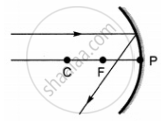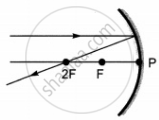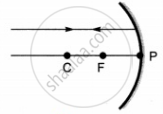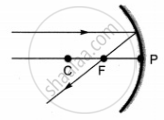Advertisements
Advertisements
Question
Which type of mirror is used in the following?
Shaving mirror
Solution
Concave mirror
APPEARS IN
RELATED QUESTIONS
It is desired to obtain an erect image of an object, using concave mirror of focal length of 12 cm.
What should be the range of distance of an object placed in front of the mirror?
Fill in the following blank with suitable word:
A concave mirror .......... rays of light whereas convex mirror ............ rays
Define (i) principal focus of a concave mirror, and (ii) focal length of a concave mirror.
For what position of an object, a concave mirror forms a real image equal in size to the object?
For what position of an object, a real and diminished image is formed by a concave mirror?
What is the minimum number of rays required for locating the image formed by a concave mirror for an object? Draw a ray diagram to show the formation of a virtual image by a concave mirror.
What kind of mirror can have a focal length of, −20 cm?
A converging mirror forms a real image of height 4 cm of an object of height 1 cm placed 20 cm away from the mirror:
(i) Calculate the image distance.
(ii) What is the focal length of the mirror?
A concave mirror produces a real image 1 cm tall of an object 2.5 mm tall placed 5 cm from the mirror. Find the position of the image and the focal length of the mirror.
What would your image look like if you stood close to a large:
concave mirror?
A concave mirror cannot be used as:
(a) a magnifying mirror
(b) a torch reflector
(c) a dentist's mirror
(d) a real view mirror
State two uses of a concave mirror.
A student has to determine the focal length of a concave mirror by obtaining the image of a distant object on a screen. For getting best result he should focus
(A) a distant tree or an electric pole
(B) a well-illuminated distant building
(C) well-lit grills of the nearest window
(D) a burning candle laced at the distant edge of the laboratory table
A student has to trace the path of a ray of light passing through a rectangular glass slab for four different values of angle of incidence.
(a) Write two important precautions for this experiment.
(b) List two conclusions the student will draw based on his experiment.
Answer the following question:
An object is placed at a distance of 30 cm from a concave lens of focal length 30 cm.
(i) Use the lens formula to determine the distance of the image from the lens.
(ii) List four characteristics of the image (nature, position, size, erect/inverted) in this case.
(iii) Draw a labelled diagram to justify your answer of the part (ii)
State whether true or false. If false, correct the statement.
When an object is at the centre of curvature of concave mirror the image formed will be virtual and erect.
Which of the following ray diagrams is correct for the ray of light incident on a concave mirror as shown in figure?

 |
 |
 |
 |
| A | B | C | D |
An erect and enlarged image can be formed by
You are provided with a convex mirror, a concave mirror, a convex lens and a concave lens. You can get an inverted image from
